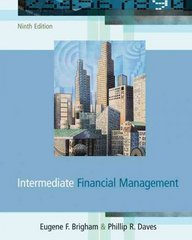Question
Consider two firms competing in prices. Both have a constant marginal cost of $10 per unit. Assume that the demand function is given by q1(p1,
Consider two firms competing in prices. Both have a constant marginal cost of $10 per unit. Assume that the demand function is given by q1(p1, p2) = 60 2p1 + p2 for the good sold by firm 1, and q2(p1, p2) = 30 p2 + p1 for the good sold by firm 2 (where qs denote quantities and ps denote prices). To summarize, firm 1s profit is
u1(p1, p2) = (60 2p1 + p2)(p1 10),
while firm 2s profit is
u2(p1, p2) = (30 p2 + p1)(p2 10).
(a) What are the firms best-responses?
(b) Find the pure-strategy Nash equilibrium.
(c) Represent equations in (a) and (b) on a graph.
(d) Suppose the price-competition game above is played twice: at the beginning of the first period, the two firms independently choose a price to charge, which determines the two firms profits in the first period; at the beginning of the second period (after observing the outcome of the first period), the two firms once again independently choose a price to charge which determines the two firms profits in the second period; both firms are assumed to cease all activities afterwards. True or False: it is possible to construct a subgame perfect Nash equilibrium in the repeated game that gives a higher profit to at least one firm in at least one of the two periods, compared to the profit it gets at the Nash equilibrium computed in (b). Argue if true or give a counter-example if not.
Step by Step Solution
There are 3 Steps involved in it
Step: 1

Get Instant Access to Expert-Tailored Solutions
See step-by-step solutions with expert insights and AI powered tools for academic success
Step: 2

Step: 3

Ace Your Homework with AI
Get the answers you need in no time with our AI-driven, step-by-step assistance
Get Started


